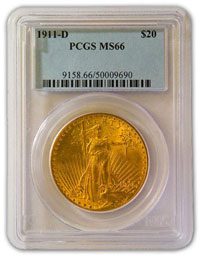Coin Grading and Certification

Coin Grading is the procedure used to determine the grade or condition of a coin. This along with its demand and scarcity are key factors in determining its value to a collector or dealer of rare coins.
The analysis that goes into grading a coin includes a number of factors, the most important being authenticity. The condition of the coin and sharpness of details also influence the grade.
Originally, there were only two grades, Mint and circulated. However, coin grading has been adjusted over the years and refined to a system of finer and finer grade distinctions.
A “grade” is a shorthand designation devised by numismatists to indicate the appearance of a coin. There are basically five main components used to determine a coin’s grade. Those being: strike, surface preservation, luster, coloration and eye appeal.
At one point the industry adopted a letter grading system beginning with the lowest grade – Basal State (also Poor (PO)), then continuing Fair (Fr), About or Almost Good (AG), Good (G), Very Good (VG), Fine (F), Very Fine (VF), Extra Fine (EF or XF), Almost or About Uncirculated (AU), Uncirculated (Unc) and up to Brilliant Uncirculated (BU). Gem Uncirculated was roughly equivalent in usage to BU at that time.
The Sheldon grading system
As the coin collector market grew in the late 19th century and early 20th century, it became apparent that a more accurate grading system was needed. Simply put, some “Fine†coins were simply “more Fine†than others. In 1948 a well-known numismatist, by the name of Dr. William Herbert Sheldon, standardize coin grading by proposing what is now known as the Sheldon Scale.
In his book “Penny Whimsy†William H. Sheldon is credited with formalizing the Sheldon Scale in the 1950s, a numeric system going from 1-70. Originally it was intended to be a reflection of the relative value of a 1794 Large Cent, but it is now applied to all series of coins. The scale runs from 1 to 70, where 1 means that it was once a coin, while 70 means that it is perfect. Uncirculated grades are Mint State (MS), beginning at MS60, and rising to MS70. Each step in the grading process reflects an improvement in quality.
To the untrained eye, this presented a possible problem. If you were unable to tell the difference between an MS 63 and MS 65 coin, you were at the mercy of the seller who established the grade (an obvious conflict of interest). Even a one-point difference in grade could mean thousands of dollars difference in value. With so much depending on opinions that varied so widely, it was difficult for collectors to justify purchasing coins of any significant value.
In 1986 and 1987, two nationally recognized independent third party grading services, Professional Coin Grading Service (PCGS) and the Numismatic Guarantee Corporation (NGC), adopted the Sheldon Scale to grade coins. Using the Sheldon Scale these two organizations independently grade each and every coin submitted to their service, eliminating any conflict of interest in coin grading.















